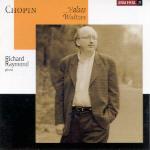At least three pianists who’ve recorded all 19 Chopin Waltzes (Magaloff, Alexeev, and Anievas) fare best in the five posthumously published pieces that stand outside the “traditional” canon of 14. The Canadian pianist Richard Raymond also imbues these five waltzes with glitter, dash, and flexibility. Elsewhere, it’s a hit and miss affair. Raymond, for example, delays the downbeat at the climax of the Op. 18 Waltz’s opening phrase, and does so predictably each time. He does a variation on the same trick in the Minute Waltz. The introspective A minor and C-sharp minor waltzes proceed in fits and starts, search in vain for continuity, and wind up back at square one. Listen to Vladimir Horowitz to hear how one can tease the lines while still playing the music straight. On the other hand, it’s refreshing to encounter the posthumous E minor waltz at a gait less breathless than usual, and Raymond’s well-timed transitions in the F major Op. 34 No. 3 should be noted. His fleet, slightly reserved A-flat Op. 64 No. 3 strikes me as a less iconoclastic replica of Rachmaninov’s poker-faced account. Among Chopin Waltz cycles, Rubinstein’s stereo remake is still unrivaled for its uncluttered sophistication, and remains my first choice.
































